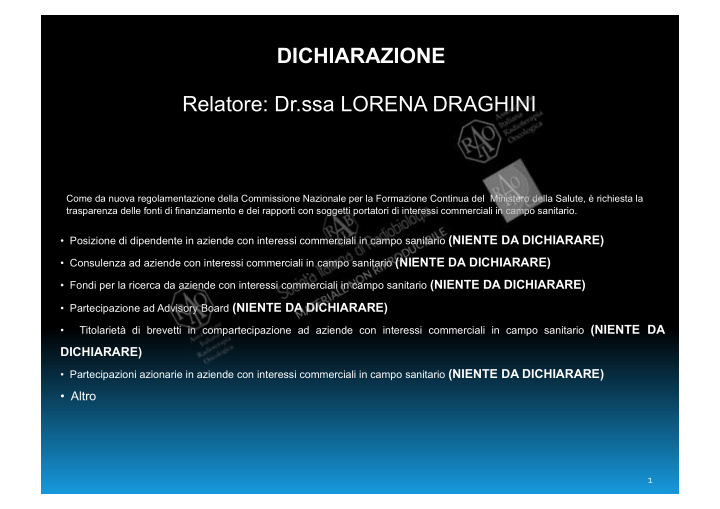



DICHIARAZIONE Relatore: Dr.ssa LORENA DRAGHINI Come da nuova regolamentazione della Commissione Nazionale per la Formazione Continua del Ministero della Salute, è richiesta la trasparenza delle fonti di finanziamento e dei rapporti con soggetti portatori di interessi commerciali in campo sanitario. • Posizione di dipendente in aziende con interessi commerciali in campo sanitario (NIENTE DA DICHIARARE) • Consulenza ad aziende con interessi commerciali in campo sanitario (NIENTE DA DICHIARARE) • Fondi per la ricerca da aziende con interessi commerciali in campo sanitario (NIENTE DA DICHIARARE) • Partecipazione ad Advisory Board (NIENTE DA DICHIARARE) • Titolarietà di brevetti in compartecipazione ad aziende con interessi commerciali in campo sanitario (NIENTE DA DICHIARARE) • Partecipazioni azionarie in aziende con interessi commerciali in campo sanitario (NIENTE DA DICHIARARE) • Altro 1 ¡
DEFINITIVE THREE DIMENSIONAL HIGH-DOSE RATE BRACHYTHERAPY (HDR-BRT) FOR INOPERABLE ENDOMETRIAL CANCER 2016 ¡ PATIENTS Dr.ssa LORENA DRAGHINI AZ. OSPEDALIERA S. MARIA TERNI DIPARTIMENTO DI ONCOLOGIA S.C. RADIOTERAPIA ONCOLOGICA DIRETTORE Dr. ERNESTO MARANZANO 2 ¡
426 (96%) surgery and adjuvant RT based on individual risk factors March 2005 -April 2016 443 endometrial cancer patients referred to our institution DEFINITIVE RADIOTHERAPY INOPERABLE FOR AGE OR COMORBIDITIES 14 (3%) definitive HDR-BRT 3 (1%) HDR-BRT after EBRT 3 ¡
METHODS • Median AGE 79 years (range, 60-95) • Median KPS 90% (range, 60-100) • HISTOLOGY: G1-2 endometrial adenocarcinoma in 9 (53%), LOW-‑RISK ¡HISTOLOGY ¡ G3 endometrial adenocarcinoma in 5 (29%) HIGH-‑RISK ¡ non-endometrial carcinoma in 3 (18%) patients HISTOLOGY ¡ (i.e. siero-papillar carcinoma in 1, clear cell carcinoma in 2 patients). • FIGO clinical stage I in 15 (88%) III in 2 (12%) • STAGING: CT- endometrial biopsy, 2 patients also MRI • 3D HDR-BRT (Fletcher system) • FOLLOW-UP: physical examination, cervical cytology and CT or MRI wherever feasible • LOCAL CONTROL : interruption of vaginal bleeding • LOCAL RELAPSE: ¡ recurrent bleeding or imaging progression & confirmatory endometrial biopsy 4 ¡
TREATMENT CHARACTERISTICS Table 1. Administered doses HDR-BRT N° of patients (%) EQD2 ( α / β 10) 2 x 7 Gy* 1 (6) 20 Gy 3 x 5 Gy* 1 (6) 19 Gy 3 x 6 Gy* 1 (6) 24 Gy 3 x 6 Gy 1 (6) 24 Gy 3 x 7 Gy 2 (12) 42 Gy 3 x 8 Gy 3 (18) 36 Gy 4 x 7 Gy 2 (12) 40 Gy 5 x 6 Gy 5 (28) 40 Gy 7 x 5 Gy 1 (6) 44 Gy EBRT 23 x 2 Gy* 1 (6) 46 Gy 25 x 2 Gy* 2 (12) 50 Gy Legend: * patients submitted to external beam radiotherapy and brachytherapy EQD2: Equivalent dose of 2 Gy per fraction calculated using the equation EQD2=([d+ α / β ]/[2Gy+ α / β ]) derived from linear quadratic model. 5 ¡
RESULTS • Median follow-up 36 months (range, 6-131) • LC rates at 3 and 6 years were 86% and 69% , respectively • CSS at 1, 2 and 7 years was 93%, 85%, 63% , respectively • Acute toxicity was registered in 2 (12%) patients: G2 nausea and G2 proctitis in 1 patient (6%), G2 diarrhea,G2 anemia and G2 proctitis in 1(6%) patient. • Two patients (12%) had G1 late rectal bleeding . 6 ¡
RESULTS UNIVARIATE ANALISYS Age, stage, dose and type of radiotherapy NO significant prognostic factors for LC and CSS LC at 1 year : 50% for stage III and 91% for stage I , BUT (p = 0.06) LC: for high risk histology is 73% at 1 year and 36% at 6 years with median duration of LC of 73 months LC: for low risk histology is 100% at 1 and 6 years , (p=0.05) 7 ¡
RESULTS Figure 1. Local control probability according to histology (p=0.05) Legend: high risk histology is non-endometrial adenocarcinoma or G3 endometrial adenocarcinoma, low risk histology is G1-2 endometrial adenocarcinoma 8 ¡
Table 2. Article of the last 10 years about definitive radiotherapy treatment for endometrial cancer using 3D HDR-BRT with or without EBRT. Author Patient Stage Type Radiation Median Local control Cancer Toxicity No. follow-up rates specific (G3-4) survival Weitmann et al. 13 I-II BRT 5-7x6-7Gy 47 months 100% at 4 yy 100% at 5 yy 0% (2005) Coon et al. 35 I-III EBRT 45Gy +BRT 33 months 93% at 3 yy 93% at 3 yy 13% (2008)* 5x4Gy 87% at 5 yy 14 BRT 5x7Gy 52 months Ohkubo et al. 9 I-II EBRT 30,6Gy+BRT 100% at 5 yy 100% at 5 yy 0% (2011)* 4x6Gy 1 BRT 4x6Gy Gill et al. (2014) 18 I EBRT45Gy+BRT 15 months 90.6% at 2 yy 100% 0% 4-5x5Gy 20 BRT 5-6x7Gy Acharya et al. 260 I EBRT - - 74% at 3 yy - (SEER) (2015) 144 EBRT+BRT 82% at 3 yy 46 BRT Acharya et al. 15 I-III EBRT48-50,4Gy+BRT 29 months 80,1% at 12yy 65,2% 4,6% (2016) 6x3,75Gy (18,9% inc. overall failures) survival at 2 28 BRT 6x6Gy yy *Some treatment plan with 2-D dosimetry 9 ¡
American ¡Brachytherapy ¡Society ¡ ¡ 2015 ¡ 10 ¡
CONCLUSIONS definitive HDR-BRT 1. Though number of patients is limited, definitive HDR-BRT for endometrial cancer could be an alternative option for inoperable patients ( e.g., elderly ones). 2. Compliance is good and toxicity limited. 3. A good LC can be achieved particularly in patients with stage I & low risk histology endometrial cancer. 4. Clinical staging with MRI is advisable to properly evaluate local extension of disease. 5. The addition of EBRT to BRT could be considered based on prognostic factors as suggest by ABS. 11 ¡
THANKS FOR THE ATTENTION lorenadraghini@gmail.com 12 ¡
Recommend
More recommend